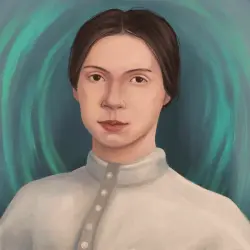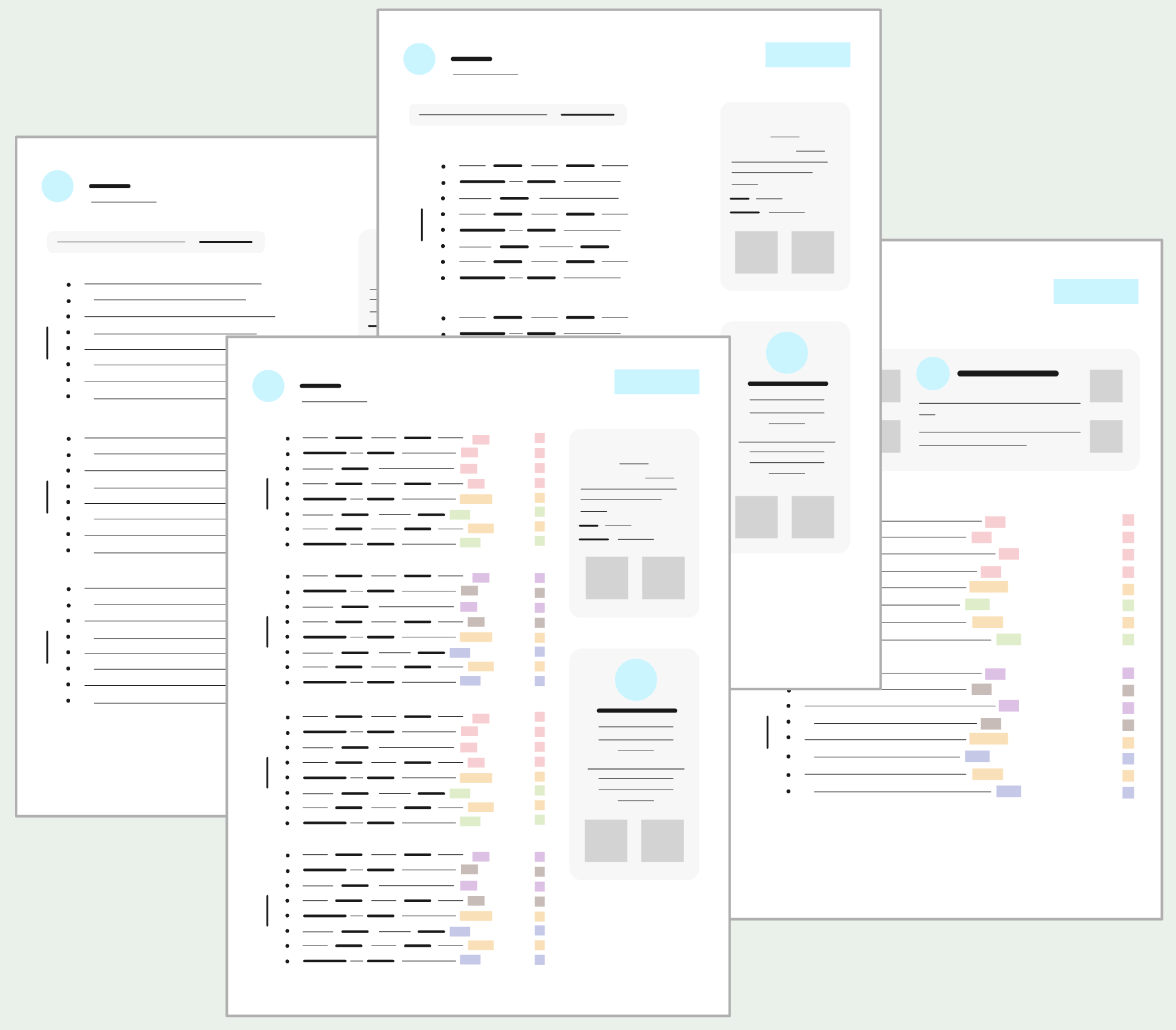This poem demonstrates elements of poetic verse less commonly seen in Dickinson’s writing. The stanzas of ‘Twas the old — road — through pain—’ are different lengths, use varying (although still repetitive) rhyme schemes, the syntax is quite simple and easy to understand (especially compared to most of Dickinson’s poems), and she uses, perhaps, the most dashes she ever used in any of her many poems.
'Twas the old — road — through pain — Emily Dickinson’Twas the old — road — through pain — That unfrequented — one — With many a turn — and thorn — That stops — at Heaven —This — was the Town — she passed — There — where she — rested — last — Then — stepped more fast — The little tracks — close prest — Then — not so swift — Slow — slow — as feet did weary — grow — Then — stopped — no other track —Wait! Look! Her little Book — The leaf — at love — turned back — Her very Hat — And this worn shoe just fits the track — Herself — though — fled! —Another bed — a short one — Women make — tonight — In Chambers bright — Too out of sight — though — For our hoarse Good Night — To touch her Head! —

Summary
‘’Twas the old — road — through pain—’ by Emily Dickinson is a poem about the path one walks throughout life and toward death.
In the first stanza of this less-commonly-read Dickinson poem, the speaker describes life as a road that one walks. Some enter Heaven at the end of it, but most do not.
The next stanza focuses on the path that a specific woman walked. At first, in her youth, she walked swiftly. But, as she aged, her feet slowed down until she arrived at her deathbed. Now, having passed away, the mourners wonder over her possessions and bid her good night. But she’s too far away, in a new heavenly bed, to hear their “hoarse Good Night.”
Themes
The main theme of this poem is death. It goes along with the woman’s hopes for her life that she lived well enough to make it into Heaven. It’s clear from the first few lines that she lived a very simple life (and from the final stanza that she did make it to Heaven).
Dickinson does not use emotional language to mourn the woman’s passing or express pity for the mourners themselves. Instead, she describes the entire process directly, implying that the same thing is going to happen to every living person, although not all of them (she suggests the majority) are going to make it to Heaven.
Speaker
The speaker is unknown. They are someone who has at least some understanding of the dying woman’s life and insight into the afterlife. It’s very likely that Dickinson regarded herself as the speaker and may have also envisioned her simple life and what she hopes will happen to her after death.
Tone
The stanzas utilize a very direct and descriptive tone that contains little emotion. These describe the woman’s progression from life to her deathbed. But in the third stanza, the tone becomes more emotional, expressing a sense of wonder over the woman’s remaining possessions.
Structure and Form
‘’Twas the old — road — through pain—’ by Emily Dickinson is a four-stanza poem. The first stanza contains four lines, the second: seven, the third: five, and the fourth: six. The use of different stanza lengths is somewhat unusual in Dickinson’s verse. She is far better known for using quatrains written in ballad meter.
In this poem, the poet also uses rhyme very consistently. In the first stanza, she uses half-rhymes, but in the second, she follows the rhyme scheme of AAA in the first three lines; the fourth line could also be described as “A” rhyme but one that’s closer to a half-rhyme than a perfect rhyme (with the following stanzas continuing this theme of rhyming). The following stanzas rhyme BBBBBCD, DDDDE, and AFFCFE.
Literary Devices
Throughout this poem, Dickinson makes use of several literary devices. These include but are not limited to:
- Repetition: the use of the same literary device in multiple lines. For example, the poet use of dashes in all the stanzas but particularly in stanza two, where the dash appears after the first word of almost every line.
- Alliteration: the repetition of the same consonant sound at the beginning of multiple words. For example, “leaf” and “love” in line two of the third stanza.
- Imagery: the use of particularly interesting descriptions that should inspire the reader’s senses. For example, “With many a turn — and thorn — / That stops — at Heaven —.”
- Anaphora: the repetition of the same word or phrase at the beginning of multiple lines. For example, “Then” at the beginning of multiple lines in stanza two.
- Personification: occurs when the poet imbues something non-human with human characteristics. For example, “as feet did weary — grow —.”
Detailed Analysis
Stanza One
‘Twas the old — road — through pain —
That unfrequented — one —
With many a turn — and thorn —
That stops — at Heaven —
In the first part of the poem, the speaker begins by describing life as a road. This is an example of an extended metaphor that runs throughout much of the poem. The road is “unfrequented” that goes to “Heaven.” This suggests that the speaker believes that far more people end up in hell, having lived poor lives than they do, having lived good ones and going to Heaven.
The repetitive use of dashes in this first stanza is indicative of the way Dickinson wanted the reader to move through the lines. Readers are forced to pause in the middle of lines (sometimes multiple times), and there is empty space at the end of almost all of the lines as well, creating a unique form of caesura and enjambment. It’s also possible that Dickinson envisioned the dashes as a way of alluding to the woman’s steps through life. Each block of words is one step on the road to death/Heaven.
Stanza Two
This — was the Town — she passed —
There — where she — rested — last —
Then — stepped more fast —
The little tracks — close prest —
Then — not so swift —
Slow — slow — as feet did weary — grow —
Then — stopped — no other track!
In the second stanza, the speaker describes parts of life’s journey. The main subject of the poem, a female character, lived in a specific town and died in a specific house. It was where she “rested — last.”
The speaker uses images associated with walking and movement, sometimes swift and sometimes not so swift, to describe the woman’s progress through life. She moved quickly at first, as a young woman, but as she aged, her feet “did weary — grow” and then “stopped — no other track!” The path she’d been walking throughout her life ran out.
Stanza Three
Wait! Look! Her little Book —
The leaf — at love — turned back —
Her very Hat —
And this worn shoe just fits the track —
Herself — though — fled!
The speaker’s tone in the third stanza shifts significantly. Here, the speaker expresses wonder and amazement from the perspective of the mourners watching on as the woman passes away. They find her “little Book” and one specific page turned down at the corner. That specific page was about “love.” The word “Book” is capitalized in the stanza, indicating that Dickinson was likely alluding to the Bible and any of a few biblical passages that speak on love.
The mourners also expressed amazement at the various items representing the woman’s life. These are scattered around her and include a hat and a shoe that “fits the track” she walked during her life. It is symbolic of who she was and what she did during her lifetime.
Stanza Four
Another bed — a short one —
Women make — tonight —
In Chambers bright —
Too out of sight — though —
For our hoarse Good Night —
To touch her Head!
The poem’s final stanza is six lines long, making it a sestet. In the stanza, the poet describes the woman in Heaven. In “Another bed,” where heavenly hands prepare her for her next life.
She’s so distant from the physical world and from the mourners who are still at this moment marveling over her possessions, to hear their testament to her life, demonstrated through the poet’s line “our hoarse Good Night.”
FAQs
The message is that no matter the kind of life you live, you face death at the end of your “track.” The poet uses simple language throughout this piece to suggest she is also interested in highlighting the simple life of an individual woman and how living well and making it to Heaven is more important than living an exciting and dramatic life and risking one’s destination after death.
The tone is initially quite simple and descriptive, containing little emotion. But, in the third stanza, it shifts to one of wonderment regarding the dying woman’s possessions and her experience in Heaven in the final stanza.
There are a few different reasons that scholars have suggested regarding Dickinson’s use of dashes in her poems. In this particular piece, ‘‘Twas the old — road — through pain—,’ It’s like she was trying to mimic the main character’s movements through life. Each dash, and the word/words in between, mimic her footsteps.
The poem is about the path that all human beings walk through life and their destination after death. The poet focuses on a woman who lived a simple life without much drama or excitement and is now entering her new life in Heaven.
Similar Poetry
Readers who enjoyed this poem should also consider reading some other Emily Dickinson poems. For example:
- ‘He ate and drank the precious words’ – an uplifting poem. It celebrates the joys of reading by describing one man’s experience.
- ‘Some keep the Sabbath going to Church –’ – features the poet’s growing disbelief regarding the customary Christian rituals and her intention to seek salvation without resorting to conventional means.
- ‘The Letter’ – is a sweet love poem. It is told from the perceptive of a love letter.


















